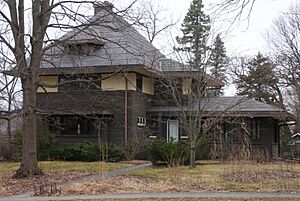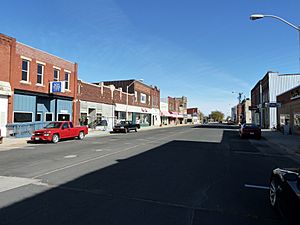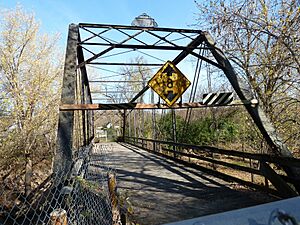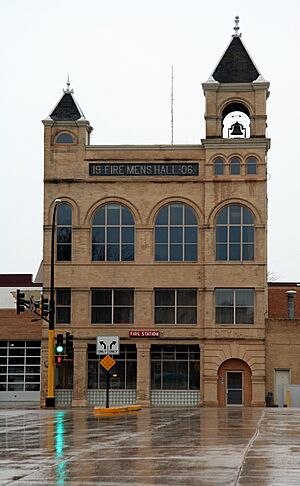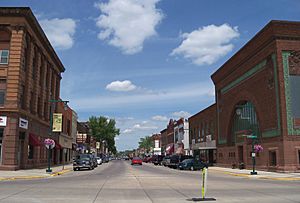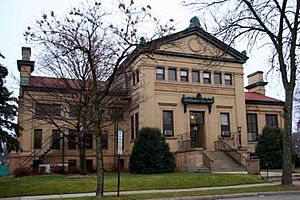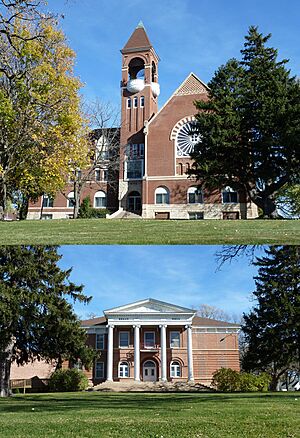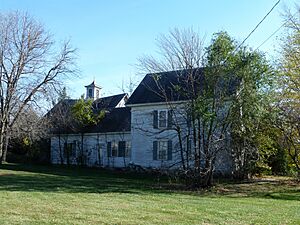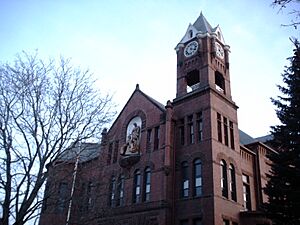National Register of Historic Places listings in Steele County, Minnesota facts for kids
Have you ever wondered about the oldest and most important buildings and places in your community? In Steele County, Minnesota, there's a special list of these places called the National Register of Historic Places. This list helps protect and celebrate buildings, structures, and areas that are important to history.
This article will tell you about the cool historic spots in Steele County that are on this list. You'll learn about old houses, schools, banks, and even a bridge! There are 13 places currently on the list, and one of them is so important it's called a National Historic Landmark. We'll also look at a few places that used to be on the list but aren't anymore.
Contents
- Cool Historic Places in Steele County
- Ezra Abbott House
- Dr. John H. Adair House
- Minnesota State Public School for Dependent and Neglected Children
- Blooming Prairie Commercial Historic District
- Bridge No. L-5573 (Clinton Falls Bridge)
- National Farmers' Bank of Owatonna
- Owatonna City and Firemen's Hall
- Owatonna Commercial Historic District
- Owatonna Public Library
- Pillsbury Academy Campus Historic District
- Daniel S. Piper House
- Steele County Courthouse
- Places That Used to Be on the List
Cool Historic Places in Steele County
Steele County is home to many interesting places that tell stories about the past. Here are some of the most important ones:
Ezra Abbott House
The Ezra Abbott House is located in Owatonna. It was built around 1860. Ezra Abbott was an important person in the early days of Owatonna. His house is a great example of the homes built by influential settlers back then. It was added to the National Register of Historic Places in 1975.
Dr. John H. Adair House
Also in Owatonna, the Dr. John H. Adair House was built in 1913. It's a beautiful example of Prairie School architecture. This style of building is known for its strong horizontal lines and open spaces. Experts say it's one of the best homes designed by the famous architects Purcell, Feick & Elmslie in southeast Minnesota. It joined the list in 1986.
Minnesota State Public School for Dependent and Neglected Children
This historic place in Owatonna actually has two parts on the National Register.
Administration Building
The main building of the Minnesota State Public School was built in 1887. It's designed in the Romanesque Revival style, which means it looks a bit like old Roman buildings with big arches. This school was active from 1886 to 1970. It was a place where children who didn't have families or homes were cared for. Today, this building holds the Minnesota State Public School Orphanage Museum and city offices. It was listed in 1975.
School Campus Historic District
The entire campus of the Minnesota State Public School for Dependent and Neglected Children is also a historic district. This means a whole area with many buildings is recognized. It includes 19 important buildings. The school was a groundbreaking place for helping children who were wards of the state. It was active from 1886 to 1947. A famous child welfare advocate named Galen A. Merrill was also connected to this school. Today, the campus is known as the West Hills Complex. It became a historic district in 2010.
Blooming Prairie Commercial Historic District
In Blooming Prairie, the main street area is a historic district. This district has many old business buildings that are still in great shape. These 21 buildings were constructed between 1893 and 1946. They show how important this town was as a trading center for farmers, especially because it was on the Chicago, Milwaukee, and St. Paul Railroad line. This district was added to the list in 1994.
Bridge No. L-5573 (Clinton Falls Bridge)
East of U.S. Route 65 in Clinton Falls Township, you'll find Bridge No. L-5573. It's also known as the Clinton Falls Bridge. This bridge is special because it was one of the first truss bridges in Minnesota to use steel when it was built in 1894. It was listed in 1997.
National Farmers' Bank of Owatonna
This bank building at 101 North Cedar Street in Owatonna is a very important historic site. It's even a National Historic Landmark! It was designed by famous architects Louis Sullivan and George Grant Elmslie. It was the first of Sullivan's unique "jewel box" banks, known for their beautiful and detailed designs. It's also part of the Owatonna Commercial Historic District. It was listed in 1971.
Owatonna City and Firemen's Hall
Built between 1906 and 1907, this building at 107 West Main Street in Owatonna served many purposes for the city. It was Owatonna's government center and is a good example of municipal buildings from the late 1800s and early 1900s in Minnesota. It's also part of the Owatonna Commercial Historic District. It was added to the list in 1997.
Owatonna Commercial Historic District
This large downtown area in Owatonna is a historic district. It covers 12 blocks and includes 75 important buildings built from 1871 to the late 1950s. This district shows how Owatonna grew and became a successful farming and industrial town and the county seat. It was listed in 2015.
Owatonna Public Library
The Owatonna Free Public Library, located at 105 North Elm Street, was built in 1899. It's known for its beautiful Neoclassical architecture, a style that looks like ancient Greek and Roman buildings. This library played a big role in the intellectual and cultural growth of Owatonna. It was added to the list in 1976.
Pillsbury Academy Campus Historic District
The Pillsbury Academy Campus in Owatonna is a historic district with five buildings constructed between 1889 and 1914. This was the only Baptist school among Minnesota's private colleges in the 1800s. The buildings are also noted for their architecture and their connection to important people like Mark H. Dunnell and George A. Pillsbury, who helped fund the school. It became a historic district in 1987.
Daniel S. Piper House
Near Medford, you can find the Daniel S. Piper House. This house, built in 1877, is unique in Minnesota. It's the only example of a New England-style interconnected farm complex. This means the house and farm buildings are all connected, which was common in New England. It represents the heritage of Yankee settlers in Minnesota. It was listed in 1975.
Steele County Courthouse
The Steele County Courthouse in Owatonna, located at 111 East Main Street, was built in 1891. It's a great example of Richardsonian Romanesque architecture, a style known for its heavy stone and arched entrances. This courthouse is also part of the Owatonna Commercial Historic District. It was added to the list in 1978.
Places That Used to Be on the List
Sometimes, historic places are removed from the National Register. This can happen if they are torn down or changed so much that they no longer look like they did historically. Here are a few places in Steele County that were once on the list:
- Clinton Falls Mills and Dam: This grist mill and dam were built between 1856 and 1859 in Clinton Falls Township. Sadly, they were demolished in 2003 and removed from the list in 2004.
- Kaplan Apartments: Located in Owatonna, this apartment building was built in 1912 by Godfrey J. Kaplan, who founded the Owatonna Tool Company. It was demolished in 2005 and removed from the list in 2007.
- Owatonna Senior High School: This school, built in 1920 in Owatonna, was designed in the Classical Revival style. It was removed from the list in 2000 after it was changed in 1998.
- Owatonna Water Works Power Station: This facility, built in 1890, helped supply water to Owatonna. It was demolished in 1992 and removed from the list in 1993.
- Steele County Courthouse (1874): An earlier courthouse in Owatonna, built in 1874 in the Italianate style. It was demolished in 1987 and removed from the list that same year.




